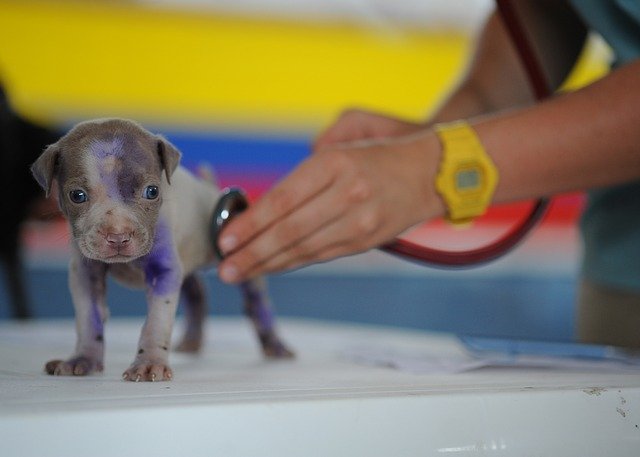Puppy (Latin name – Febris catarrhalis infections canum), is a highly contagious disease that affects several organ systems and belongs to the group of so-called multisystem diseases.
The disease is of viral origin, and it got its name because it mostly occurs in puppies or young dogs; the disease is known in professional veterinary terminology as biphasic fever.
The cause of puppies and the way the disease occurs
As stated at the beginning of the text, the puppy is a viral infectious disease, and its causative agent belongs to the family Paramyxoviridae, and also belongs to the RNA viruses (which have the ability to multiply within the infected cells or in the cell cytoplasm and nucleus, in which they form “Inclusion bodies”).
The virus itself is very resistant to external conditions and can survive in the external environment for a very long time (the causative agent tolerates lower external temperatures much better, so the infection usually occurs more often in the winter); on the other hand, it can be destroyed by a number of chemicals, such as ether. It is paradoxical that the causative agent of puppies was first found and isolated from the serum of the family of big cats (lions; tigers; leopards), but that it does not cause infection in them – in other words, these animals are only a reservoir and source of infection, but themselves they never get sick.
It is also very important to note that the puppy is not transmitted to humans from diseased dogs. It is believed that the puppy virus was imported to Europe from Asia, and the first case of the disease was registered in Spain in the 18th century.
The mode of transmission of the infection and the factors that contribute to the development of the disease in dogs
The causative agent of puppies is introduced into the dog’s body either by inhalation (inhalation, ie by droplets), or indirect contact with infectious secretions of diseased dogs (nasal secretions; tears; saliva; urine and feces). Also, the infectious agent that causes this disease is transmitted indirectly, more precisely through infected objects (toys; food and / or water containers; pet beds), which were used by the infected dog.
Puppies usually affect puppies aged 3-6 months, as well as unvaccinated young and adult dogs (although studies have shown that with the growth of the dog or age, the incidence of the disease decreases – provided that the dog is regularly and timely vaccinated ).
Puppies of vaccinated dogs have so-called passive protective antibodies, ie acquired immunity that they receive from the mother through the placenta and through milk after their birth; however, this protection is short-lived (and lasts about 5-6 weeks), and also in some puppies, the level of antibodies can be naturally low so that those puppies that get sick from puppies die soon after birth.
Breeds of dogs that are particularly sensitive or that are most affected by puppies are – Cocker Spaniel; German Shepherd and Irish Setter.
The mortality rate from puppies is still very high today and ranges from 30-80%, and primarily depends on whether the dog has been vaccinated, as well as on the condition of his immune system, ie on the general resistance of the organism. Thus, adult dogs that have not been vaccinated or that have some form of immunosuppression, after contact with infected animals, will usually have a severe chronic form of the disease involving the structures of the central nervous system (which will be discussed later in this text).
Factors that increase the risk of infection or facilitate the onset of the disease (so-called predisposing factors) are – improper diet (malnutrition; avitaminosis); common cold, ie cold (which damages the mucous membrane of the upper respiratory tract, and thus facilitates the penetration of pathogens into epithelial cells); the existence of intestinal parasites in the dog’s body; decline in general resistance, ie the body’s defenses in dogs (immunosuppression).
Clinical manifestations of puppies
After penetrating the dog’s body, the viral causative agent of puppies multiplies intensively in the lymph tissue (tonsils and lymph nodes), from where it easily penetrates the bloodstream and thus causes the first stage of two-phase fever – the so-called viremia stage.
In the mentioned first phase of the disease, the virus is present in the blood cells; in the cerebrospinal fluid; and in the serum of diseased animals. Viremia is accompanied by a marked decrease in the number of lymphocytes (which leads to severe immunosuppression, ie a decrease in immunity in the dog); a drop in platelet count, and a sudden “jump” in body temperature to 41 ° C.
After the viremia stage, there is a period of falling body temperature to normal values (because specific antiviral antibodies are present in a certain number in the dog’s serum), while the viral agent is further transmitted through the bloodstream to various tissues and organs of the infected animal. continues its active reproduction).
When the puppy virus reaches the epithelial cells of the respiratory mucosa; mucous membranes of the digestive tract; to the mucous membrane of the urinary tract and to the epithelial cells of the skin – the second stage of biphasic fever occurs, with an increase in temperature to 40 ° C (and with accompanying symptoms by diseased organs, ie organ systems.
The most severe form of the disease (with the highest risk of potential death) occurs when the virus enters the cells of the CNS, ie the brain, and when it manifests itself in neurological disorders and convulsions in dogs.
The main problem is a large number of dogs is the late detection of the disease and the consequent delay in starting treatment (when the disease is already significantly advanced), and the main reasons for this phenomenon are very common asymptomatic or subclinical forms of the disease (which make up over half of all clinical forms of puppies). ), or the existence of natural or acquired resistance of the organism (acquired resistance is achieved by vaccination, which is the best measure of prevention against puppies).
Clinical forms of “two-phase fever” in dogs
The incubation period (time interval in which there are no clinical symptoms, ie the period in which the virus multiplies in the body), in puppies can last for different lengths (which primarily depends on the state of the dog’s immune system and virulence of the pathogen), but the rule is about 3-6 days.
Clinical forms of puppies (which occur after the mentioned incubation period) are:
Subclinical form of the disease – which does not show visible clinical signs and symptoms (the virus is present in the body and can be detected by serological tests), and which accounts for about 50-70% of all forms of puppies and significantly complicates timely diagnosis;
The mild clinical form of the disease – which usually occurs with the manifestation of milder clinical manifestations such as – loss of appetite and weight loss in dogs; apathy and apathy; fatigue and lethargy; fever; symptoms of upper respiratory tract infection (cough; difficulty breathing, ie dyspnea; runny nose in the form of serious or mucopurulent secretions); constriction; and hypersalivation (increased salivation;
The acute form of the disease – can manifest as pulmonary; gastrointestinal; cutaneous or nervous. This clinical form of puppies is considered a typical manifestation of the disease and is manifested by:
– the occurrence of two-phase temperature – where the first increase in body temperature is a consequence of the already mentioned viremia, and as a rule occurs after the incubation period, and lasts about 8-48 hours; after passing this first phase of fever, the temperature returns to normal values (and then a big diagnostic error can be made because the dog looks completely healthy at first glance), which lasts about 24-48 hours; the second febrile stage, occurs after the apparent “calming of the fever”, and can last for a different period of time (which primarily depends on the resistance of the organism and which organs or organ systems are affected by the infection);
– the appearance of accompanying symptoms by the respiratory system – runny nose; rhinitis; inflammation of the pharyngeal mucosa; tonsillitis; laryngitis; bronchitis; a cough that is first dry and then “productive”. The most dangerous and most severe respiratory complication is the development of bronchopneumonia, ie pneumonia, when the dog has difficulty breathing, suffocates from the accumulated purulent secretion in the airways, and in the end, can very often die;
– signs of digestive tract dysfunction – diarrhea; vomiting; anorexia; gastroenteritis; the appearance of mucus and / or blood in the stool and the development of severe dehydration; the dog is exhausted and emaciated; the tongue is dry, white and coated; there is marked dryness of the mouth and bad breath; the dog’s snout is also dry. The intestinal and respiratory acute form of puppies (which is characterized by the appearance of all the mentioned clinical symptoms), are collectively called a catarrhal form of the disease and are usually accompanied by very common secondary bacterial infections (which tend to worsen the clinical picture and significantly complicate treatment);
– The cutaneous form of the acute puppy represents the easiest clinical picture of the disease (provided that it appears as an independent form) and is characterized by the appearance of skin changes in the form of vesicles and/or pustules (the former are filled with clear contents and the latter are filled with pus). by shooting, “living wounds” remain on the animal’s skin, which is later covered with crusts. As a rule, skin lesions occur primarily in those places where the skin of dogs is thinnest – on the lower side of the abdomen; in the region of the inner thigh; on the skin of the external auditory canal;
– The neurological form of an acute puppy, as a rule, occurs at the very end of the acute phase of this disease and is manifested – by the appearance of completely discordant, ie uncoordinated movements (so the dog has problems maintaining balance and often falls “to the side”); the occurrence of spasms of one or more groups of skeletal muscles; the appearance of convulsions; mental disorders; the appearance of paresis and paralysis (primarily the muscles of the legs and “face” in the dog). Death in the acute neurological form of puppies, as a rule, occurs as a consequence of encephalomyelitis (inflammation of the brain) and/or its complications;
The chronic form of the disease – is characteristic of older dogs that have manifestations of CNS involvement, but usually without the appearance of other systemic manifestations; this clinical form of the disease usually ends in death (especially if the dog has not been vaccinated or revaccinated in time; if his body is weakened by the previous acute phase of the puppy or the existence of another almost “overdue” disease);
Diagnosis of puppies and differential diagnosis according to other diseases
The diagnosis of puppies is usually made on the basis of the anamnesis, which was obtained from the dog’s owner (that the dog was not vaccinated; that the disease appeared in the winter), as well as on the basis of a typical clinical picture or previously described symptoms.
So-called pathohistological examinations, in the epithelial cells of the skin; in glial brain cells; as well as in the epithelium of the mucous membranes of the respiratory, digestive and urogenital tracts, the already mentioned “inclusion bodies” can be found, the findings of which in positive animals are positive in more than 70% of cases.
Although in case of suspicion of a puppy, laboratory tests are not a common diagnostic procedure, they can often be of great help to confirm the diagnosis. Blood counts in puppies include thrombocytopenia; lymphopenia; anemia; on the other hand, serological tests show an increase in the titer, ie the level of specific antiviral antibodies in the serum of a diseased dog.
Puppies are sometimes difficult to distinguish from the following diseases – toxoplasmosis; parvovirus infections; leptospirosis; salmonella infections; as well as from traumatic CNS injuries and from spina bifida.
Treatment of puppies
The therapeutic approach to this disease in dogs consists primarily of raising the body’s immune and defense forces, as well as in symptomatic therapy (procedures that alleviate the clinical symptoms of the disease).
In the initial phase of the disease (in the first 2-3 days), therapy involves the use of so-called hyperimmune serums; when, after incubation of the disease, its clinical manifestations are manifested, the therapy of puppies is never completely successful.
Due to very frequent secondary infections (primarily pathogenic bacteria), broad-spectrum antibiotics are usually introduced into the therapy.
In symptomatic therapy, proper nutrition (enriched with proteins and carbohydrates, and low in fat) is very important, as well as the addition of vitamins (A, C, D and B vitamins) and minerals either in the form of special food formulas or in the form of supplements.
In the neurological form of puppies, anticonvulsant therapy is given, primarily phenobarbitone; corticosteroids are given to reduce brain edema (but the symptoms only disappear while the therapy lasts, and return immediately after stopping its use). When there is a severe neurological picture of the disease, and no therapeutic approach gives results, the dog must be put to sleep or euthanasia must be performed.
Prevention – vaccination of dogs against puppies
As already mentioned in the text, the best measure of prevention against puppies is the regular vaccination of dogs at the appropriate ages. It is very important to note that before vaccination, the dog must be “cleansed” of both external and internal parasites, and that vaccination is effective only if it is complete – which means that the dog is protected only if it receives all doses of vaccine.
The first vaccine is given to puppies from 7-8 weeks of age, in the form of a bivalent vaccine (vaccine against puppies and parvovirus) – vaccine Nobivac Puppy DP;
The second vaccination (so-called booster dose) is carried out at 10 weeks of age, and it is a well-known polyvalent DHPP + L vaccine (against puppies; hepatitis; parvovirus; parainfluenza virus and against leptospirosis) – Vanguard plus 5 vaccines;
The third vaccination is carried out in the 14th week of the puppy’s life, with a polyvalent DHPP + L vaccine in addition to the vaccine against Coronavirus infection;
Revaccination is further carried out every year with the polyvalent DHPP + L vaccine, once during a calendar year, for life in all dogs, in order to maintain immunity.





